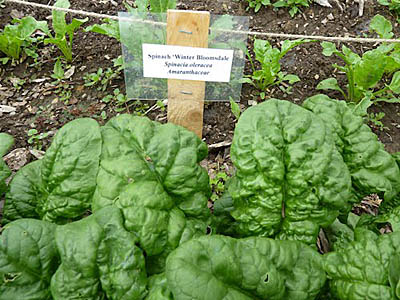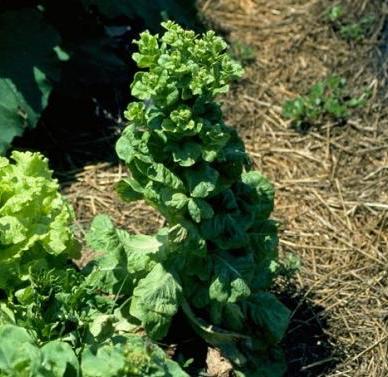Mastering the Art of Growing Spinach
An Interview with Richard Padgett, FCMGA Member
By Elizabeth Cornell Fake, Fairfax Master Gardener
 True to form, Mother Nature provides us with Spinach (Spinacia oleracea), one of the most nutrient dense foods, in early spring when we have depleted our winter store. Packed with vitamins A, C, D, B-6, and B-12, and minerals, Calcium, Iron and Magnesium, it gives us a nutritious, green flowering plant with tender, edible leaves. FCMGA member, Richard Padgett, has been enjoying a winter/spring harvest of this power packed vegetable for over seven years and offers his advice on how to be a spinach pro.
True to form, Mother Nature provides us with Spinach (Spinacia oleracea), one of the most nutrient dense foods, in early spring when we have depleted our winter store. Packed with vitamins A, C, D, B-6, and B-12, and minerals, Calcium, Iron and Magnesium, it gives us a nutritious, green flowering plant with tender, edible leaves. FCMGA member, Richard Padgett, has been enjoying a winter/spring harvest of this power packed vegetable for over seven years and offers his advice on how to be a spinach pro.
When did you first start growing spinach?
I have had a community garden plot in Reston for about 20 years. Although I enjoy the plot all year, I like fall gardening best because the weather is temperate, there are fewer bugs and you can sow some vegetables in the late summer and harvest in October/November. About seven years ago I noticed a garden neighbor had great early spring Spinach and told me about planting in the fall, so I decided to give it a try.
When do you plant and what happens?
I usually plant Spinach in early October with the intention of overwintering the plants. I’ve had the most success planting around Columbus Day, but for a successful spring harvest the plants need a decent start before the days get too short. The plants will grow very slowly through early November, but if you have two to six leaves by Thanksgiving you should be good. So, it is probably better to plant a little early than too late. When I start the Spinach in October, I can begin harvesting in late February or early March. lasting through May. If I plant in March, the Spinach will not be available until April. Whether you plant in October or March, Spinach bolts in May, because of rising temperatures and the amount of sunlight, so the difference is four months of Spinach instead of two.

Spinach plant bolted
No. Spinach is hardy to 15 degrees or less. Although we may have some very cold days in December and January, I don’t seem to lose the crop because of weather. If it snows, that’s all to the good as it adds moisture to the soil. In the winter, I scrape the snow off the Spinach bed and see green leaves. Spinach doesn’t die, whereas other greens do. I often cover my Arugula with white cloth during the winter, but don’t have to cover the Spinach.
How do you plant?
 I plant in rows following the seed package directions. I dig 3/4 inch deep furrows, spread the seeds, cover with soil and then tamp to about a ½ inch depth. This past fall I soaked the seeds in water overnight before planting, but my germination rate was way down. I will reconsider that technique in the future. My current garden plot is 15 years old and is about 20 percent organic material. I amend the soil every year with compost, leaf mulch and stable muck from a local stable.
I plant in rows following the seed package directions. I dig 3/4 inch deep furrows, spread the seeds, cover with soil and then tamp to about a ½ inch depth. This past fall I soaked the seeds in water overnight before planting, but my germination rate was way down. I will reconsider that technique in the future. My current garden plot is 15 years old and is about 20 percent organic material. I amend the soil every year with compost, leaf mulch and stable muck from a local stable.
What varieties do you plant?
I have very reliable results with Bloomsdale Long Standing, which is hardy, has large thick leaves and thick stems. Noble Giant is another variety that is similar. I do not plant Baby Spinach because it is too much work for the results. I am most interested in plant productivity.

Richard Padgett
• Spinach, Home & Garden Information Center, Clemson Cooperative
Extension, Factsheet HGIC 1320
• Vegetable Seed Production: Spinach, Greg Welbaum, Department of
Horticulture, Virginia Tech